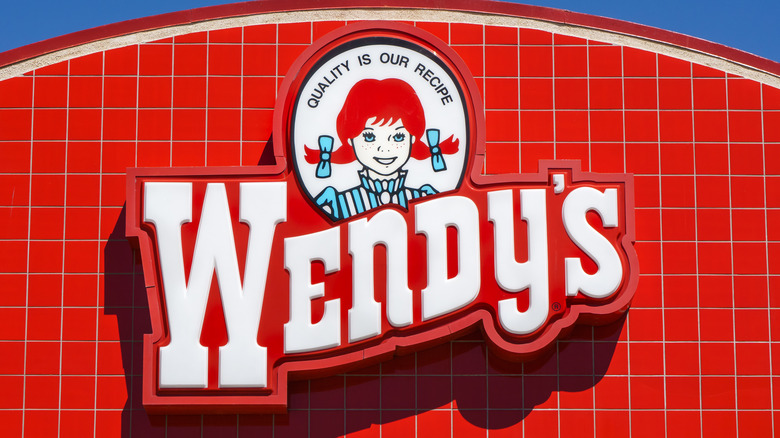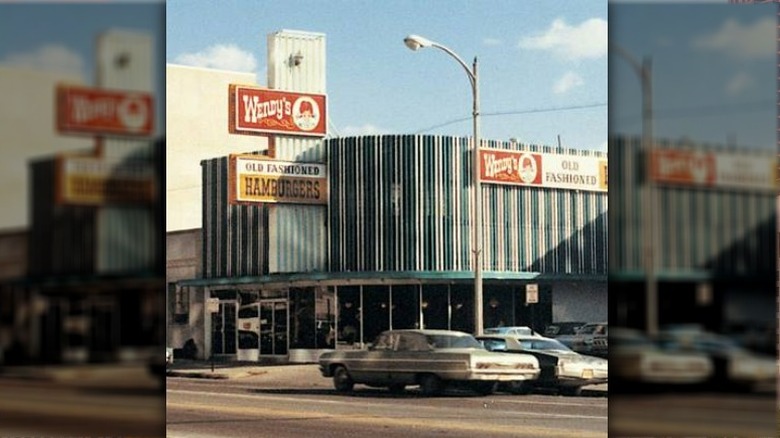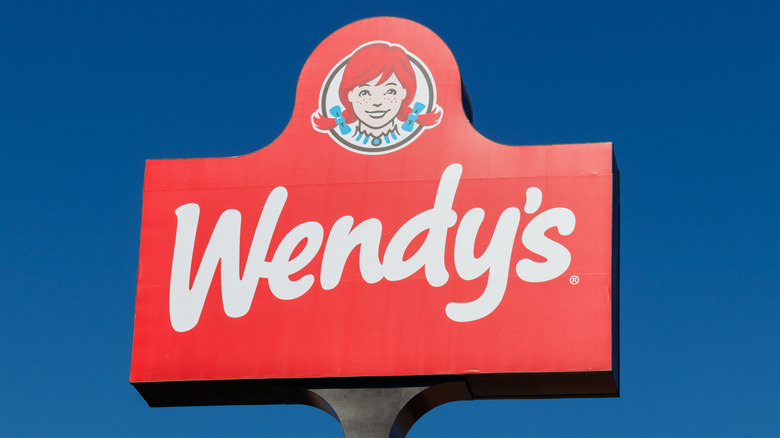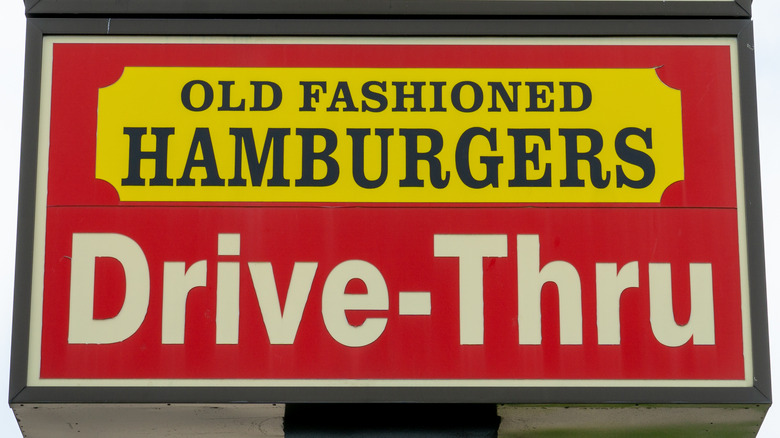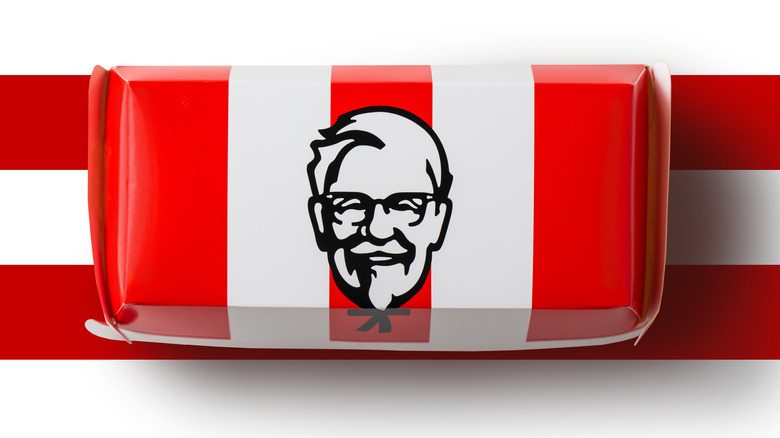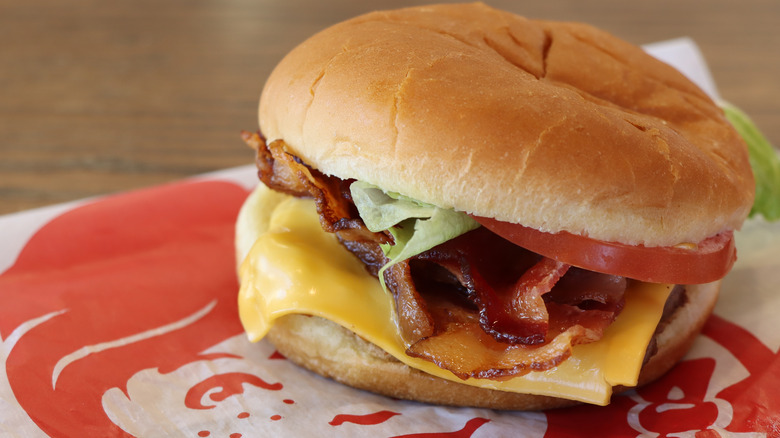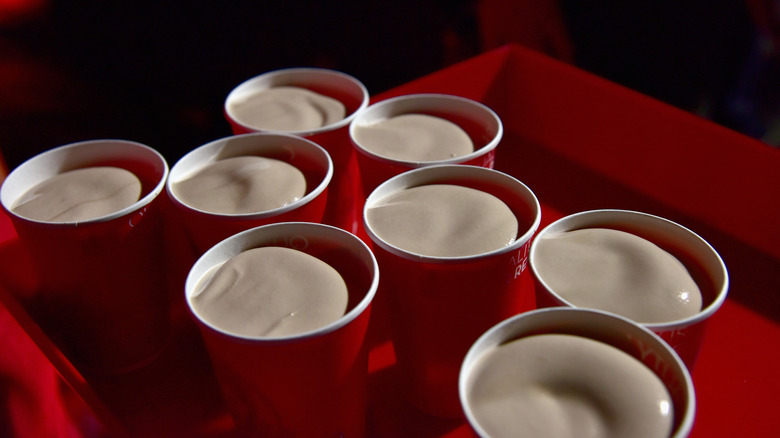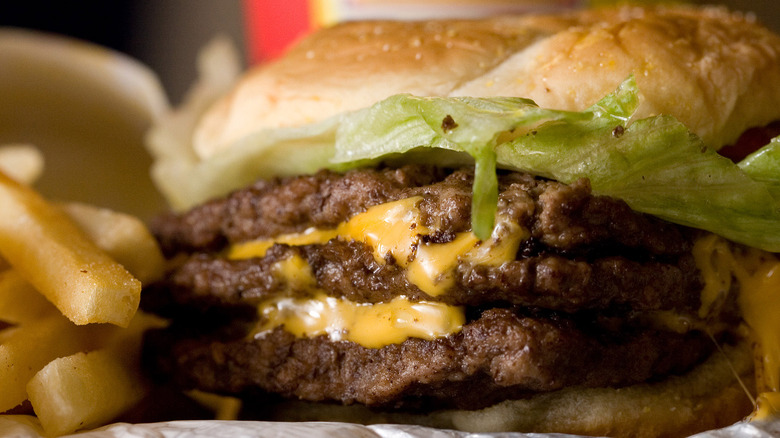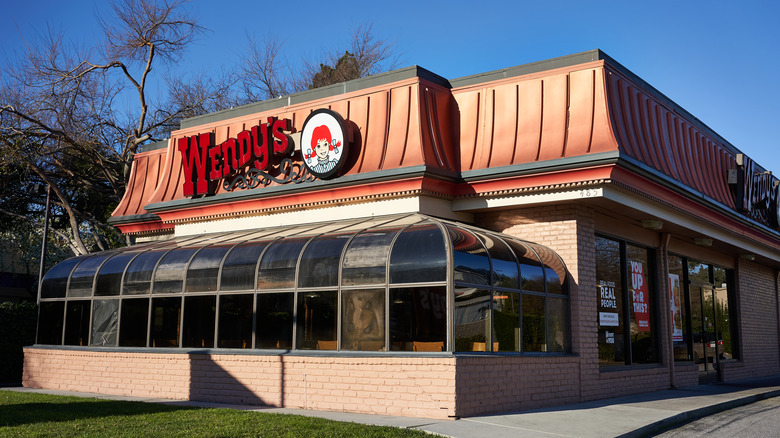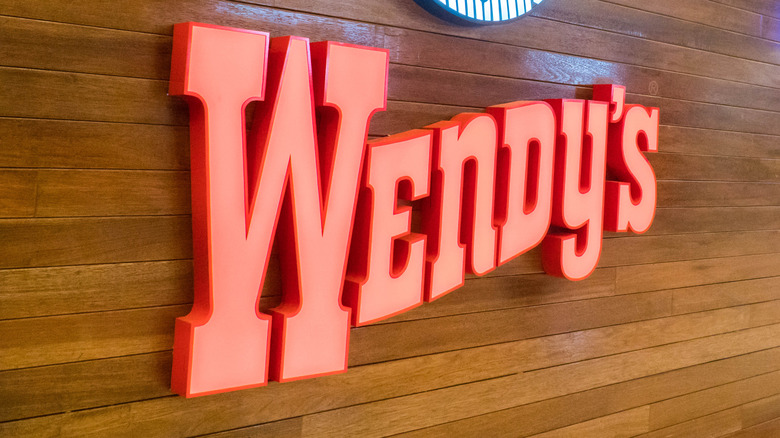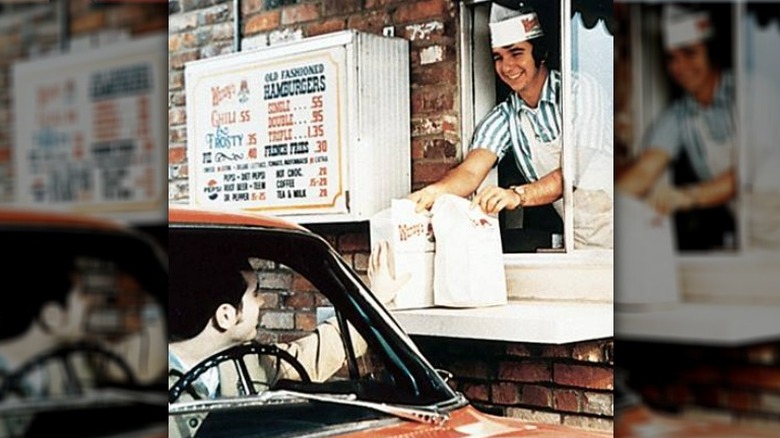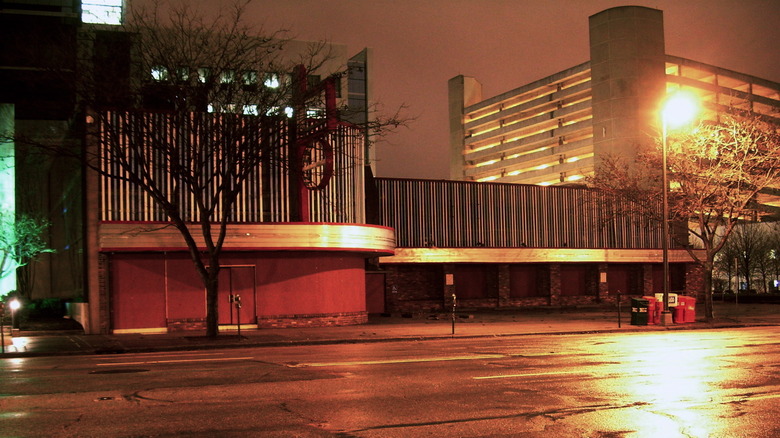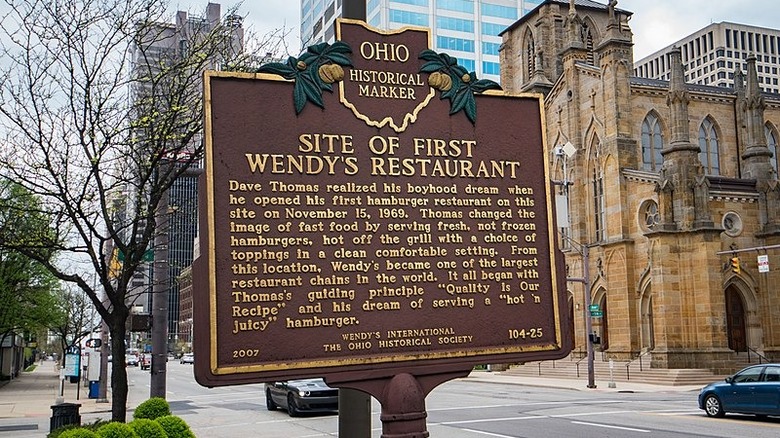The Secret History Of Wendy's First Restaurant
Seems nearly everyone has a solid reason for liking Wendy's. Their "Fresh, Never Frozen" philosophy is long embedded in America's palate for those who don't mind the square patties.
If you've dined-in or tried the drive-thru you know that Wendy's is more than just old-fashioned hamburgers. The decor is warm and the menu's inviting. Your go-to Wendy's likely has a familiar aroma, a scent blending the best whiffs of a hamburger stand with the nostalgic comfort of your grandma's kitchen. A place where the ingredients are crisp and the Frosty is treated like royalty — a milkshake so heavenly viscous it's served with a spoon.
For over 50 years Wendy's restaurants have delighted customers with their made-to-order sensibilities and wholesome family atmosphere. But when did customers first experience that blessed aroma of walking into a Wendy's? And where on Earth did the Frosty come from?
The behind-the-scenes story behind all the above starts in Ohio.
The first Wendy's opened up in Columbus, Ohio
On November 15, 1969, Dave Thomas went franchise mode and opened up an old-fashioned hamburger joint focused on wholesome ingredients and a wholesome atmosphere. The first Wendy's appeared on Broad Street in downtown Columbus, Ohio, and as we all know, it wouldn't be Thomas' lone brick-and-mortar.
From day one, Wendy's was far unlike their competition. The interior of the original and subsequent franchises was furnished more like a family den. If you ordered-in you could eat in a carpeted dining area, lit by stained-glass lamps suspended from the ceiling. The cozy environment proved worth the investment, as Thomas soon opened a second Wendy's restaurant in Columbus. The success of these two operations led to Wendy's becoming a franchise of meteoric expansion. The capital seat of the Buckeye state serving as the petri dish to one of today's largest fast-food chains in America.
The name Wendy was chosen thanks to a mispronunciation of Melinda
Dave Thomas had five kids and not one was named Wendy. But the name and image of Wendy's was inspired by his daughter Melinda Lou. Manifesting in a roundabout way through a derivation of her childhood nickname, Wenda.
"Wenda's" siblings had trouble pronouncing her real name, and Thomas' slight tweak to the sobriquet yielded Wendy's — a nickname that really stuck. More than the name, Melinda Lou is also the logo. Her visage set in stone after a photo shoot where she donned a blue-and-white dress made by her mother, and with pig-tails held together by pipe cleaners, posed as Wendy's first and only emblem.
Although innocent in intention, Thomas would later admit he regretted the decision to name his restaurant after his daughter and her likeness. According to Melinda, Thomas told her he wished he'd have made a different choice in naming, as he felt the whole situation put undue pressure on her.
Dave Thomas founded Wendy's after reportedly being unable to find a good hamburger in Columbus
According to Biography.com, Dave Thomas was a man unable to find a hamburger meeting his expectations, so he decided to craft his own and incidentally built a sprawling restaurant empire.
But as we all know today, Thomas did more than just craft a different kind of burger. He introduced the square patty, surrounded it with crispy vegetables, and kept it fresh, delivering a burger stand taste that's never soggy. The idea of a square burger was unique, but it was meant to showcase the juicy burger — the shape allowed the edges of the meat to stick out from the round bun. It was an idea that worked, as Wendy's would open their second location in Columbus soon after, and then start serving those burgers to the rest of the world in pretty short order.
The founder of Wendy's was previously a head cook at KFC
Dave Thomas intersected with some interesting allies during his rise through fast food. Playing a pivotal role in the success of other famous franchises, including KFC.
Having served as an enlisted cook in the Korean War, Thomas had copious experience when he was discharged and made the move to KFC's kitchen in the 1950s. Although it's clear to see his ambition now, it must have been quite the sight to behold when Thomas started giving orders to the Colonel.
Because Thomas didn't only cook KFC's chicken, he also spiced up their image. Delivering business innovations that proved not only successful, but served to be iconic.
KFC's old rotating outdoor sign that looked like a bucket? That was Dave Thomas' idea. Thomas also suggested that Sanders make appearances on TV, and it launched such a successful series of ad campaigns, it's a space where the Colonel's likeness still shines today.
Selling his stake in KFC provided Dave Thomas the funds to start Wendy's
Thomas accrued responsibilities at KFC like an Eagle Scout. His good deeds ranged from trimming down the menu to expanding KFC's chain of locations. At one point being offered a large stake in four Columbus KFC franchises if Thomas could improve their bottom lines. Thomas succeeded, and KFC was so impressed that they promoted him to regional director of operations.
The only issue was this was ultimately Colonel Sanders' operation, and Thomas would never run the business So having secured a good chunk of seed money, Thomas decided to stake his funds into something of his own.
Thomas liquidated his lucrative stake in KFC, to the tune of $1.5 million in 1968 dollars. And at the age of 35, he was ready to embark on his life's mission, and open up the world's first Wendy's.
The iconic Frosty dessert made its debut in the original Wendy's
The years spent as a head cook under multiple roofs paid off. As Thomas spun off his line chef expertise into expert menu-building, issuing hit after hit from the inaugural Wendy's menu. The hearty chili, the old-fashioned hamburgers, and a mighty dessert that would quickly become a household name: The Wendy's Frosty.
One of the thickest almost-milkshakes in all of fast food, the Frosty immediately declares its uniqueness upon order, arriving paired with a plastic spoon. Quickly served, but slowly enjoyed, the Frosty is so counterintuitive that it's enamoring. Impossible to imbibe by straw unless it's melted or you possess a trumpeter's cheeks, the Frosty is another example of Thomas going left when everyone else thought they were right.
The Frosty is a delight that spans generations as it was one of the first five items on the Wendy's menu. The clean-up hitter in a lineup loaded with classics that have stuck around.
The beef was fresh then just like it is now
Dave Thomas wasn't a "Born Again" believer in quality either. He knew the direction of his company and the compass pointed to fresh ingredients. None more important than the beef. Long before the "Where's The Beef?" ads of the 1980s, Thomas would keep it real by keeping the patties out of the freezer. A decision that was initially panned due to the perceived costliness of using fresh beef, until Wendy's won over public opinion and fans responded to the fresh flavor.
Wendy's new wave, but old-fashioned way of doing business showed you could scale wholesome taste into mass product. Allegedly inspired by the square patties of Kewpee Burgers (via AtlasObscura.com), a fast-food chain that once spanned the Midwest, Thomas thrust this burger geometry both into the mainstream and into metaphor. Because whenever asked "Why the square patties?" Thomas would famously insist that it was because Wendy's didn't cut corners.
Wendy's first location was a hit, and led to rapid franchise expansion
After earning his stripes cooking for the troops in the Korean war, and cooking for the Colonel at Kentucky Fried, it's safe to say Dave Thomas knew exactly what he was doing behind the counter.
But what about all the overhead that came with running it on your own? Well within a year of opening that first Wendy's locations, the world was aware that Thomas could handle that as well. His gauntlet of past experiences shined through as Wendy's consistently surpassed the benchmarks Thomas initially envisioned. Desiring just enough revenue to run a small family business, Wendy's would achieve much more than that — expanding to over 1,000 new locations in the next ten years, and doubling that number in the 1980s. Today, Wendy's is one of the largest fast-food corporations in America, with over 5,000 locations in the United States (via Scrapehero.com).
The first Wendy's restaurant also served as a museum
Over their years of burger-selling success, the original Wendy's location accrued artifacts belying their expanding legacy. According to Roadside America, priceless items such as their original square griddle could be seen resting on a plaque in the dining area. Glass-walled displays were also common, preserving the wardrobe of characters who starred in Wendy's ads, including the blue-and-white dress worn by their very first star, Melinda Lou, aka "Wenda," aka Wendy.
Wendy's had developed a die-hard fan base and the fans kept coming back for the memorabilia, and the original Wendy's had evolved into a pop-culture museum of its own making. Of course, they also continued serving burgers and Frostys. Mixing quality and kitsch was their specialty — fans dined in a universe of Wendy's lore, basking in view of many of their beloved and off-kilter ad campaigns.
The original Wendy's had no drive-thru window
Although Wendy's did pioneer the modern conception of the drive-thru, its inception would not arrive until 1971 at another location, according to Roadside.com. Also, it's tough to design the first drive-thru when the supporting architecture did not yet exist. The original Wendy's was located in downtown Columbus, and the lot wasn't conducive to that innovation. The store backed up to the very busy Broad Street, so retroactively installing a drive-thru would've been too much overhaul for a budding restaurant.
Thomas instead focused on a family-style fast-food restaurant and lobbied for fresh ingredients. Innovating with secret menus and simple, but avant-garde offerings. Once Wendy's was tabled for expansion, Thomas would take the drive-thru idea out of the drawer and install it into his second restaurant. Sparking yet another fast-food revolution as the rest of the industry soon followed suit and the drive-thru became a modern ubiquity.
Unfortunately, the first Wendy's location is no longer open
All good runs must come to an end, and the inaugural Wendy's location had to bow out in 2007. According to NBC News, although management kept this franchise open longer than it should have out of sentimentality, the company said the sagging sales at the location were insurmountable.
What made the original Wendy's so appealing was also likely part of its downfall. No room for a drive-thru, not much for parking either. The world had moved on from the building codes of 1969. The fans and suits dutifully kept the nostalgia alive for an extended period, but even Dave Thomas reportedly knew his flagship was struggling, prior to his death in 2002.
The hope for a museum was not lost in the closure. As Wendy's has always kept an eye out for their fans, they reshuffled their flagship to Dublin, Ohio, where they'd try to recreate history once again with all the memorabilia removed from the original Wendy's.
They did their best to recreate the original Wendy's in Dublin, Ohio
Seeing that the museum carried obvious appeal to Wendy's die-hards, the company built their fans a field of their dreams in the form of a flagship restaurant in Dublin, Ohio.
All-in-all the Dublin location is truly a shine to Wendy's. According to Bizjournals.com, the restaurant spans 4,000 square feet with three separate dining areas and can sit over 100 patrons. Including a patio with enough seating to accommodate 24 outside.
The location has preserved Wendy's nostalgia while striding into the future. Featuring flat-screens, self-order kiosks, and wi-ii, while setting aside a large "Community Room" filled to the walls with Wendy's lore.
An entire room in the new restaurant is dedicated to Wendy's history, but you could argue the entire establishment also serves as a monument to Dave Thomas — his iconic visage appearing everywhere, and his original work still made-to-order.
